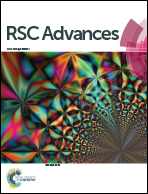In situ generated and stabilized Pd nanoparticles by N2,N4,N6-tridodecyl-1,3,5-triazine-2,4,6-triamine (TDTAT) as a reactive and efficient catalyst for the Suzuki–Miyaura reaction in water†
Abstract
In situ generated Pd nanoparticles in the presence of N2,N4,N6-tridodecyl-1,3,5-triazine-2,4,6-triamine (TDTAT) were found to be an efficient catalyst for the Suzuki–Miyaura coupling reaction in water. It seems that TDTAT not only acts as a ligand for stabilization of the produced nanoparticles, but also as a surfactant to facilate the reaction in water, and reduces Pd(II) to Pd(0). The TEM analysis of the reaction mixture showed that Pd nanoparticles with an average size of ∼5 nm are produced, which act as an efficient catalyst in the Suzuki–Miyaura coupling reaction.


 Please wait while we load your content...
Please wait while we load your content...